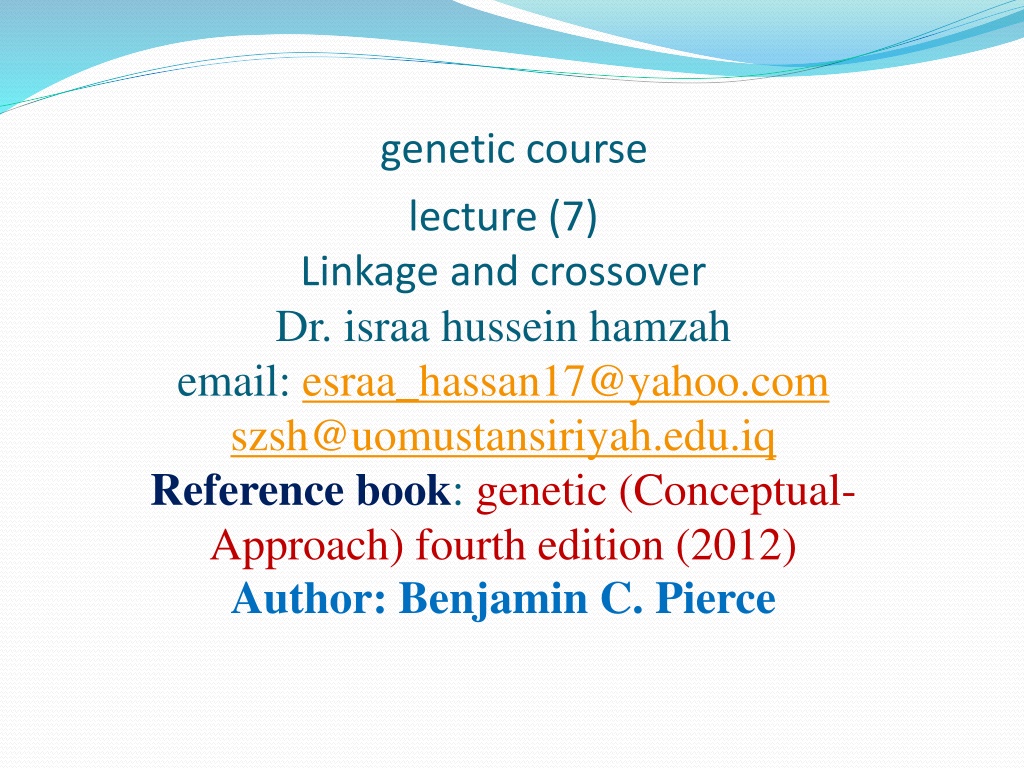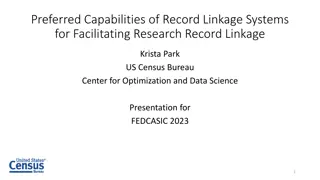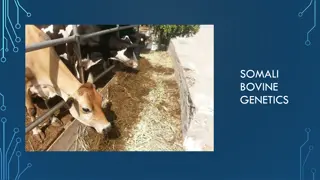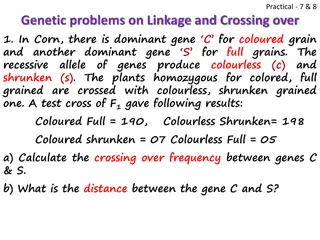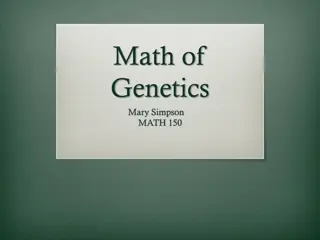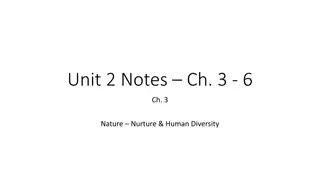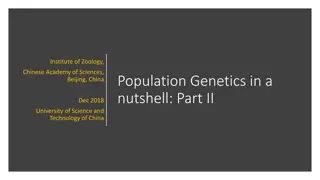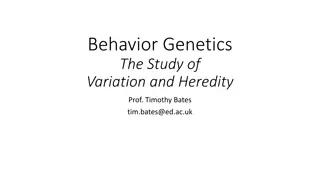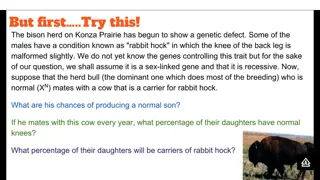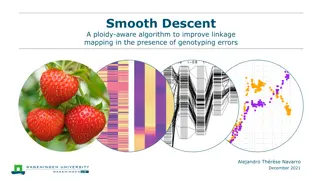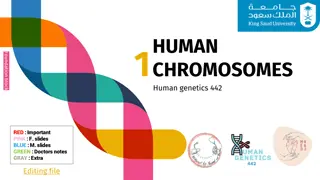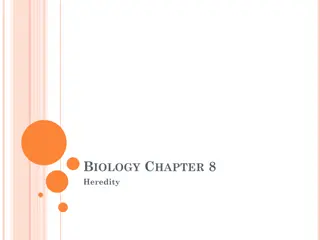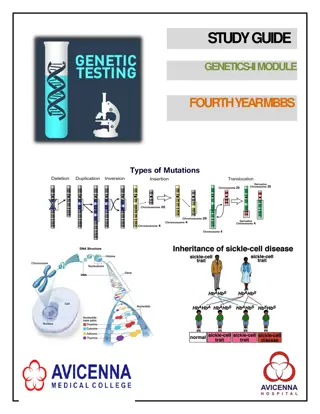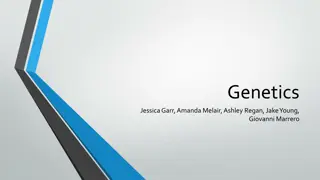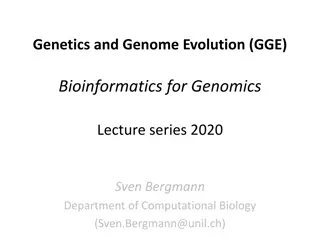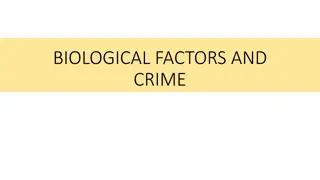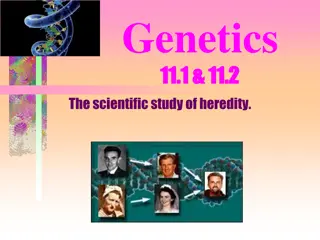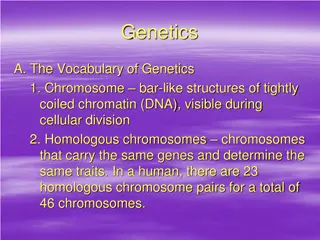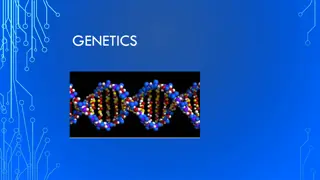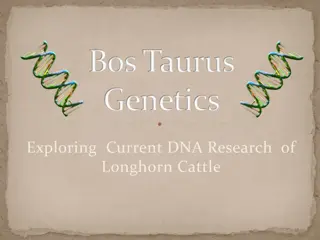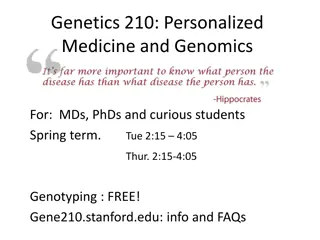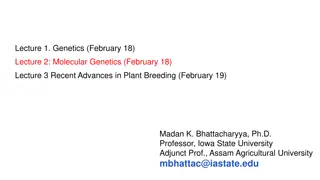Understanding Linkage and Crossover in Genetics
Genes determining individual characteristics are carried in chromosomes, with some genes linked and inherited together. This linkage affects how genes assort in offspring, following principles of inheritance like Mendel's laws. The Chromosome Theory of Linkage explains how the distance between genes influences the strength of linkage. Understanding these concepts is crucial in genetic studies and inheritance predictions.
Download Presentation

Please find below an Image/Link to download the presentation.
The content on the website is provided AS IS for your information and personal use only. It may not be sold, licensed, or shared on other websites without obtaining consent from the author. Download presentation by click this link. If you encounter any issues during the download, it is possible that the publisher has removed the file from their server.
E N D
Presentation Transcript
genetic course lecture (7) Linkage and crossover Dr. israa hussein hamzah email: esraa_hassan17@yahoo.com szsh@uomustansiriyah.edu.iq Reference book: genetic (Conceptual- Approach) fourth edition (2012) Author: Benjamin C. Pierce
Linkage The hereditary units or genes which determine the characters of an individual are carried in the chromosomes and an individual usually has many genes for the determination of various different characters. As there are more genes than the chromosomes, it can be expected that each chromosome contains more than one gene. The genes for different characters may be either situated in the same chromosome or in different chromosomes. When the genes are situated in different chromosomes, the characters they control appear in the next generation either together or apart, depending on the chance alone. They have assorted independently according to Mendel s law of independent assortment.
But if the genes are situated in the same chromosome and are fairly close to each other, they tend to be inherited together. This type of coexistence of two or more genes in the same chromosome is known as linkage. The difference between independent assortment and linkage can be understood by the following two examples : P1 : AA BB aa bb P1 gametes : (AB) (ab) F1 : Aa Bb Test cross : Aa Bb aa bb Gametes : (AB) (Ab) (aB) (ab) (ab) F2 : Aa Bb : Aa bb : aa Bb : aa bb or 1 : 1 : 1 : 1
Example 2. Linked genes do not assort independently, but tend to stay together in the same combination as they were in the parents. In the following figure, the genes to the left of the slash line (/) are on one chromosome and those on the right are on the homologous chromosome. P1 : AB/AB ab/ab P1 gametes : (AB) (ab( F1 : AB/ab Test cross : AB/ab ab/ab Gametes : (AB) (ab) (ab) F2 : AB/ab : ab/ab Or 1 : 1. This type of large deviation of F2 results of example 2 from a 1 : 1 : 1 : 1 ratio in the test cross progeny of dihybrid is an evidence for linkage.
Chromosome Theory of Linkage Morgan along with Castle formulated the chromosome theory of linkage which is as follows: 1. The genes which show the phenomenon of linkage are situated in the same chromosomes and these linked genes usually remain bounded by the chromosomal material so that they cannot be separated during the process of inheritance. 2. The distance between the linked genes determines the strength of linkage. The closely located genes show strong linkage than the widely located genes which show the weak linkage. 3. The genes are arranged in linear fashion in the chromosomes
by their investigation on the Drosophila and other organisms have found two types of linkage, viz., complete linkage and incomplete linkage. 1- Complete Linkage The complete linkage is the phenomenon in which parental combinations of characters appear together for two or more generations in a continuous and regular fashion. In this type of linkage genes. are closely associated and tend to transmit together. Example. The genes for bent wings (bt) and shaven bristles (svn) of the fourth chromosome mutant of Drosophila melanogaster exhibit complete linkage. KINDS OF LINKAGE:- T.H. Morgan and his co-workers
Complete linkage in male Drosophila. In most of the organisms crossing-over takes place both in males and females. But in male Drosophila and female silkworm, crossing-over takes place either very rarely or not at all. This becomes clear from Morgan s(1957) experimental results from Drosophila. In 1919, T.H. Morgan mated gray bodied and vestigial winged(b+vg/b+vg) fruit flies with black bodies and normal long wings (bvg+/bvg+).
gray bodied and vestigial winged black bodies and normal long wings b+vg/b+vg x bvg+/bvg+ F1 b+vg/bvg+ progeny had gray bodies and normal long wings indicating thereby that these characters are dominant. Test cross : F1 male Gray, Long Female Black, Vestigial b+vg/bvg+ bvg/bvg Gametes : (b+vg) (bvg+) (bvg) only two types of gametes due to complete linkage and lack of crossing over in male Drosophila b+vg/bvg bvg+/bvg : Gray, Vestigial : Black, Long 1: 1
When F1 males (b+vg/bvg+), were backcrossed (i.e., test crossed) to double recessive females (bvg/bvg or black vestigial), only two types of progeny (one with gray bodies and vestigial wings, b+vg/bvg and the other with black bodies and normal wings, to bvg+/bvg instead of four types of phenotypes were obtained. Here, the use of the testcross is very important. Because one parent (the tester) contributes gametes carrying only recessive alleles, the phenotypes of the offspring represent the gametic contribution of the other double heterozygote parent. So the genetical analyst can concentrate on one meiosis and forget the other. This is in contrast to the situation in an F1 where there are two sets of meiotic divisions to consider one for the F1 male parental gametes and one for the F1 female.
2. Incomplete Linkage The linked genes do not always stay together because homologous non-sister chromatids may exchange segments of varying length with one another during meiotic prophase. This sort of exchange of chromosomal segments in chromosomes is known as crossing over The linked genes which are widely located in chromosomes and have chances of separation by crossing over are called incompletely linked genes and the phenomenon of their inheritance is called incomplete linkage. between homologous
Fig 1: Crossover between chromatids of a pair of homologous chromosomes
Incomplete linkage in female Drosophila. When F1 females of the Morgans classical cross in Drosophila between gray, vestigial (b+vg/b+vg) and black, normal or long (bvg+/bvg+) were testcrossed to double-recessive (bvg/bvg) males, all four types of progeny were obtained in following ratio, showing the occurrence of crossing-over: Parents : Gray, Vestigial Black, Long b+vg/b+vg bvg+/bvg+ Gametes : (b+vg) (bvg+) F1 : b+vg/bvg+ Gray, Long Test cross : F1 Female Gray, Long Male Black, Vestigial b+vg/bvg+ bvg/bvg Gametes : (b+vg) (bvg+) = Non-cross overs (bvg) (b+vg+) (bvg) = Recombinants
Test cross ratio : 1- Gray, Vestigial; b+vg/bvg = 41.5% 83% parental combination 2- Black, Long; bvg+/bvg = 41.5% showing linkage 3- Gray, Long ; b+vg+/bvg = 8.5% recombinants due to 4- Black, Vestigial; bvg/bvg = 8.5% crossing over 17%
LINKAGE GROUPS All the linked genes of a chromosome form a linkage group. Because, all the genes of a chromosome have their identical genes (alleomorphs) on the homologous chromosome, therefore linkage groups of a homologous pair of chromosome is considered as one. The number of linkage group of a species, thus, corresponds with ha ploid chromosome number of that species. Example. 1. Drosophila has 4 pairs of chromosomes and 4 linkage groups. 2- Man has 23 pairs of chromosomes and 23 linkage groups. 3-. Corn (Zea mays) has 10 pairs of chromosomes and 10 linkage groups. However, in organisms the female or male sex having dissimilar sex chromosomes Drosophila, fowl, etc.), one more linkage group occur than the haploid number (e.g., human beings,
1. Female human beings = 22 pairs of autosomes or non-sex chromosomes + 1 pair of : homomorphic X chromosomes = 22 autosomal linkage groups + 1 X chromosomal linkage group 23= linkage groups. 2-Male human beings : = 22 pairs of autosomes + 2 heteromorphic sex chromosomes, = 22autosomal linkage group + 1 X chromosomal linkage group + 1 Y chromosomal linkage group = 24 linkage groups. SIGNIFICANCE OF LINKAGE The phenomenon of linkage has one of the great significance for the living organisms that it reduces the possibility of variability in gametes unless crossing over occurs. Q-How many linkage groups are there in the (a) human male, (b) human female, (c) female grasshopper and (d) male grasshopper. (a) 24; (b) 23 (c) 12; (d) 12. Example.
Crossing over crossing over in which the non-sister chromatids of homologous chromosomes exchange the chromosomal parts or segments. In another words the crossing over is a process that produces new combinationse (recombinations) of genes by interchanging of corresponding segments between non- sister chromatids of homologous chromosomes . The chromatins resulting from such interchanges of chromosomal parts are known as cross overs. The term crossing over was coined by Morgan. No crossing over occurs in male Drosophila and female silk worm, Bombyx mori. Certain external agents such as heat shock, chemicals, radiations, etc., have profound effect on crossing over
Characteristics of Crossing Over 1-. Crossing over or recombination occurs at two levels )i) at gross chromosomal level, called chromosomal crossing over and (ii) at DNA level, called genetic recombination. 2-. A reciprocal exchange of material between homologous chromosomes in heterozygotes is reflected in crossing over. 3-. The crossing over results basically from an exchange of genetic material between non-sister chromatids by break-and- exchange following replication. 4-. The frequency of crossing over appears to be closely related to physical distance between genes on chromosome and serves as a tool in constructing genetic maps of chromosomes.
TYPES OF CROSSING OVER According to its occurrence in the somatic or germ cells following two types of crossing over have been recognized : 1. Somatic or Mitotic Crossing Over When the process of crossing over occurs in the chromosomes of body or somatic cells of an organism during the mitotic cell division it is known as somatic or mitotic crossing over.The somatic crossing over is rare in its occurrence and it has no genetical significance. The somatic or mitotic crossing over has been reported in the body or somatic cells of Drosophila by Curt Stern and in the fungus Aspergillus nidulans 2- Germinal or Meiotic Crossing Over Usually the crossing over occurs in germinal cells during the gametogenesis in which the meiotic cell division takes place. This type of crossing over is known as germinal or meiotic crossing over. The meiotic crossing over is universal in its occurrence and is of great genetic significance.
MECHANISM OF MEIOTIC CROSSING OVER 1-. Synapsis Synapsis or intimate pairing between the two homologous chromosomes (one maternal and another paternal) is initiated during zygotene stage of prophase I of meiosis I Synapsis often starts when the homologous ends of the two chromosomes are brought together on the nuclear envelope and it continues inward in a zipper-like manner from both ends, aligning the two homologous chromosomes side by side (e.g., mammals). In other cases, synapsis may begin in internal regions of the chromosomes and proceed toward the ends, producing the same type of alignment. By synapsis each gene is, thus, brought into juxtaposition (=being side by side) with its homologous gene on the opposite chromosome. Thus, synapsis is the phase of prolonged and close contact of homologous chromosomes due to attraction between two exactly identical or homologous regions or chromomeres. The resultant pairs of homologous chromosomes are called bivalents.
2-. Duplication of Chromosomes The synapsis is followed by duplication of chromosomes (in pachytene). During this stage, each homologous chromosome of bivalents splits longitudinally and form two identical sister chromatids which remain held together by an unsplitted centromere. The longitudinal splitting of chromosomes is achieved by the separation of already duplicated DNA molecules along with certain chromosomal proteins. At this stage each bivalent contains four chromatids, so it is known as tetrad.
It is well evident that crossing over occurs in the homologous chromosomes only during the four stranded or tetrad stage. Homologues continue to stay in synapsis for days during pachytene stage and chromosomal crossing over occurs due to exchange of chromosomal material between non-sister chromatids of each tetrad. In pachytene, the recombination nodules become visible between synapsed chromosomes During the process of crossing over, two non-sister chromatids first break at the corresponding points due to the activity of a nuclear enzyme known as endonuclease. ). Then a segment on one side of each break connects with a segment on the opposite side of the break, so that a segment on one side of each break connects with a segment on the opposite side of the break, so that the two non-sister chromatids cross each other. At this stage .3 per cent synthesis of DNA (i.e., P DNAreplication) occurs to fill the gap. The fusion of chromosomal segments with that of opposite one takesplace due to the action of an enzyme known as ligase. The crossing of two chromatids is known as chiasma (Gr., chiasma=cross) formation. The crossing over, thus, includes the breaking of chromatid segments, their transposition and fusion. Chiasma frequency or percentage of crossing over. The crossing over may take place at several points in one tetrad and may result in the formation of several chiasmata. The number of chiasmata depends on the length of the chromosomes because the longer the chromosome the greater the number of chiasmata. In a species each chromosome has a characteristic number of chiasmata.
The frequency by which a chiasmata occurs between any two genetic loci has also a characteristic probability. The more apart two genes are located on a chromosome, the greater the opportunity for a chiasma to occur between them. The closer two genes are linked lesser the chances for a chiasma occurring between them. 4-. Terminalisation After the occurrence of process of crossing over, the non-sister chromatids start to repel each other because the force of synapsis attraction between them decreases. During diplotene, desynapsis begins, synaptonemal complex dissolves and two chromosomes in a bivalent are pulled away from each other. During diakinesis, chromosomes detaches from the nuclear envelope and each bivalent is clearly seen to contain four separate chromatids with each pair of sister chromatids linked at their centromeres, while non-sister chromatids that have crossed over are linked by chiasmata. The chromatids separate progressively from the centromere towards the chiasma and the chiasma itself moves in a zipper fashion towards the end of the tetrad. The movement of chiasma is known as terminalisation. Due to the terminalisation the homologous chromosomes are separated completely. homologous
KINDS OF CROSSING OVER According to the number of chiasma following types of crossing over have been described. 1-. Single crossing over. When the chiasma occurs only at one point of the chromosome pair then the crossing over is known as single crossing over. The single crossing over produces two cross over chromatids and two non-cross over chromatids. 2-. Double crossing over. When the chiasmata occur at two points in the same chromosome, the phenomenon is known as double crossing over. In the double crossing over, the formation of each chiasma is independent of the other and in it four possible classes of recombination occur. 3-Multiple crossing over. When crossing over takes place at more than two places in the same chromosome pair then such crossing over is known as multiple crossing over. The multiple crossing over occurs rarely.
SIGNIFICANCE OF CROSSING OVER The phenomenon of crossing over is universal in its occurrence and it occurs in viruses, bacteria, moulds, plants and animals. It is necessary for the natural selection because due to this the chances of variation increase
